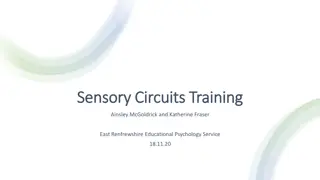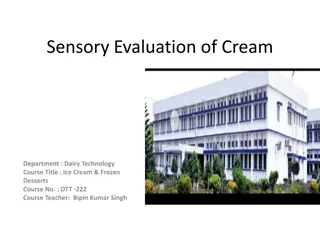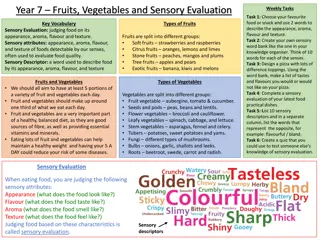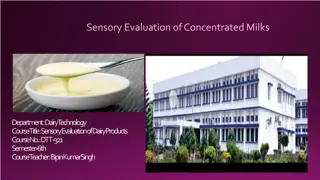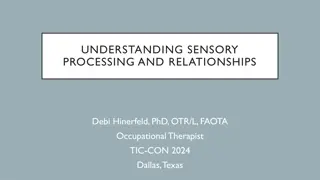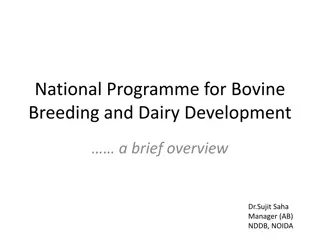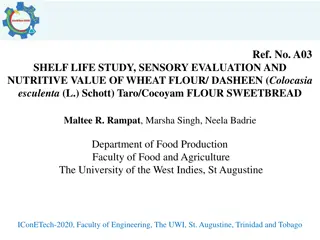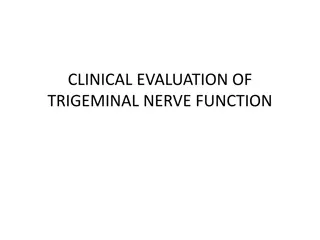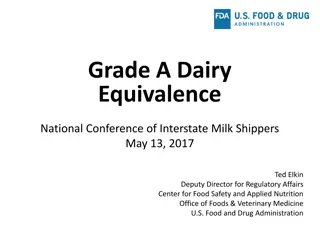Fundamental Rules for Sensory Evaluation of Dairy Products
Essential guidelines for conducting sensory evaluation of dairy products include being in good physical and mental condition for scoring, avoiding certain foods before judging, maintaining a clean sensory laboratory, having knowledge of score cards and defect identification, and ensuring samples are properly tempered for accurate evaluation. Understanding the importance of proper preparation and environment is crucial in assessing the quality of dairy products effectively.
Download Presentation

Please find below an Image/Link to download the presentation.
The content on the website is provided AS IS for your information and personal use only. It may not be sold, licensed, or shared on other websites without obtaining consent from the author. Download presentation by click this link. If you encounter any issues during the download, it is possible that the publisher has removed the file from their server.
E N D
Presentation Transcript
Fundamental Rules for Sensory Evaluation DEPARTMENT : DAIRY TECHNOLOGY COURSE TITLE : SENSORY EVALUATION OF DAIRY PRODUCTS COURSE NO. : DTT -321 COURSE TEACHER: BIPIN KUMAR SINGH
FUNDAMENTAL RULES: Following rules for sensory evaluation of Dairy Products are required to conduct judging . Be in physical and mental condition for scoring: a). Heavy meal eating just prior to judging leads to dull the appetite, and to destroy the enthusiasm for tasting and the sensitivity of taste. b). Judging of diary products after having eaten foods of strong flavor such as cabbage, turnips, or onions should be avoided. c). The use of tobacco is generally detrimental to the development of the senses of taste and smell, it must be admitted that some dairy products' judges noted for their abilities to judge are inveterate smokers. In some cases it is believed that the use of tobacco is not harmful to one's judging ability. d)The use of mild - flavored pepsin chewing gum prior to judging is considered beneficial to the flow of saliva thus preparing the tongue and palate for the sapid substances. Chewing appears to stimulating the flow of saliva and have a nerve quieting effect. e). Sensory Laboratory should be clean, well ventilated, well lighted and tempered to contribute to the physical comfort of the judge. f). Wash room facilities should be available. The mouth should be rinsed with plain water prior to judging. The hands should be scrubbed, using a non-fragrant soap
FUNDAMENTAL RULES: The person should have the knowledge of the score card or the ideals established for each product: The score card is an important tool for the dairy products' judge. Judge should be able to recall instantly the numerical value of each sample for each attributes. Have the ability to grade each dairy product and to judge the defect intensities allowed in each grade: The judge must have ability to identify the defects and their intensities for flavor, body and texture, colour and overall acceptability of the product. He should has the knowledge of the relative desirability or undesirability of each in terms of numerical values. Thus, to judge a product one must know what to expect in the way of quality of each product.
FUNDAMENTAL RULES: The samples should be properly tempered: The flavor and the body and texture can be determined best when the products are neither too cold nor too warm. Therefore, each product should be tempered specifically for particular dairy product. The ice cream and butter, cheese and milk are required to be tempered around 5F to 10F. (- 15 to - 12.2 .) 60F. (15.5 ) respectively to the study of the various qualities. If the products are too cold, the taste buds may be temporarily anesthetized during which time some of the delicate, elusive flavour may pass off undetected. On the other hand, if the products are too warm, an accurate evaluation of some of the qualities is very difficult.
FUNDAMENTAL RULES: The sample to be judged should be a representative portion of a lot: The sample should be taken accurately and be representative of whole lot. After proper pretreatment of the sample should be given to judges. Sample should not be taken from surface portion, or a trier plug which touches an opening from where a previous, or a trier plug which touches an opening from where a previous sample had been removed. In case of liquid products, as milk, buttermilk, or cream, be certain that the product should be well mixed before sampling Observe the aroma immediately after removal of the sample: The judging of sample depends upon the experience and practice.The best time to smell a sample is when the freshly cut surface is first exposed to the air. If the aroma is not observed then, its true intensity may never be recorded. Other qualities of the product may be examined after noting the smell, since they remain fairly constant. The importance of examining the aroma of the sample immediately upon removal of such sample cannot be overemphasized. Bear in mind always that the nose is far more sensitive than the tongue : "As little as one billionth of a milligram of an aromatic vapor is detectable by the human nose. In order to taste the same substance, the tongue requires a million times as much. the significance of this ratio is not generally appreciated by food processors."
FUNDAMENTAL RULES: Introduce sufficiently large volume of the product into the mouth for tasting: The sample should be large enough that delicate flavors may be detected, and yet sufficiently small to permit easy manipulation of the warmed sample in the mouth. Be in no hurry to expectorate the sample. It should be rendered completely liquid and warmed to body temperature before being rejected. Hold each sample approximately the same length of time in the mouth regardless of the quality of the product. The sample tasted is rarely swallowed and then only on specific occasions. Fix the proper ideal quality of products in mind: This can best be done by working closely with a sample recognized as having superior quality. Learn to recognize when and in what respect a sample fails to compare favorably with the ideal. Without the attainment of this mental guide or standard, the amateur judge has no ''yardstick'' by which to measure the products. The earlier the ideal quality of a product is grasped the sooner will the beginner become proficient in judging and grading dairy products.
FUNDAMENTAL RULES: Observe the sequence of flavors: The sensory reactions for specific flavors remain the same. They may be depended upon to give the same sensations the next time they are brought into contact with the sense organs. Remember these sensations and correlate them as early as possible with the specific flavor. After expectorating, note how long before the taste sensation disappears. Practice introspection: That is, close the eyes and mind to the world about you and practice self examination so far as tasting is concerned. Think into your own mind and make mental records of the taste and smell reactions. In other words, concentrate upon the sample being examined to the exclusion of everything else. Practice concentration during scoring of a sample until it becomes a fixed habit of judging.
FUNDAMENTAL RULES: Recondition the mouth occasionally:The mouth should be cleansed or reconditioned at intervals of tasting, especially after having examined a poor sample. This may be done satisfactorily by a). rinsing the mouth with clean warm water or warm water to which a small amount of salt has been added. b). rinsing the mouth with water or with one of the solutions reconditions the mouth satisfactorily after having tasted milk and ice cream. c). the use of salt water or fruit seems best suited for conditioning the mouth after having tasted butter and cheese. d). use clean warm water to aid in keeping the mouth in condition after having tested products such as buttermilk, cultures, or cultured cream. e). eating portions of sound firm fruit, such as an apple or a pear.
FUNDAMENTAL RULES: Do not be too critical: The taste and aroma of the sample requires careful observation. The questionable habit of trying to find objectionable flavors which may not be present contributes much toward the improvement of the imagination, but does little to increase one's judging ability. However, be certain that the sample has been well examined and whether defects are present. Give the sample the benefit of the doubt. In addition, keep an open mind in judging. Once the mind is made up do not change it. Check your own scoring occasionally: This can best be done by comparing the flavors of two or more identically scored samples and observing whether the flavors are scored consistently. Frequently, a good check on consistency of scoring should be made by re-scoring unknown samples without knowing their identity. Re-scoring unknown samples identically with the first scoring contributes much to the establishment of confidence and mental poise in the developing amateur judge..
FUNDAMENTAL RULES: Be honest with yourself: Judge should be honest. Judge the sample itself and should not be influenced by the name, the trade-mark on the package or by the score previously given a like product from a particular plant. Concentrate on judging the samples at hand. He should keep a straight face and by so doing avoid telegraphing his observations intentionally or otherwise to another judge. Recognize the fact that practice and experience are essential to the development of judging ability: To develop the ability to taste, smell, and distinguish the delicate, one must practice judging of dairy products. Do not become discouraged too easily. Frequenataly, all that is needed to reveal powers of taste and smell is training and practice. Concentration, perseverance, and continued actual judging practice will yield astonishing results.



